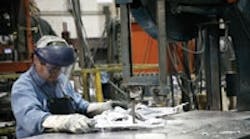If computer numerical control (CNC) equipment was developed to enhance the performance of machine tools, then why have manual machines survived -- and continue to thrive? In fact some job shop owners indicate that manual machines are an important factor in their success.
Okay, so maybe manual machines aren't surviving or thriving with the same exuberant excitement as CNC equipment. Nor is it likely that manual machines will emerge triumphant in the emerging technology display area at this fall's International Machine Tool Show (Sept. 8-13 in Chicago). And it's true that trade magazines don't run them very often on their covers or on their advertising pages.
And yet... manual machine tools continue to prevail. Most any manufacturing plant in the U.S. will have a few, at least one, typically located in their maintenance or prototyping departments. That continues even though the major builders don't build or market manual machines in the United States. New manual machines typically come from Europe or Asia.
But U.S. builders will have manual equipment on their premises. For example, a Mazak Corp. spokesman recently admitted to the presence of manual equipment (unknown brand!) located in the maintenance department at the company's Florence, Ky., site. That's in contrast with the company's production floor where it prides itself on having, using and showing customers the latest and most advanced CNC equipment.
Job shops, on the other hand, are usually depicted as manual machine users that are scheming to enter the more productive and costly CNC world. But like many generalizations, that one also falls short. Consider that many job shops -- and other users of manual machines as well -- sometimes need efficient solutions for very short runs, one-offs for prototyping or to machine repair parts for maintenance purposes.
For example, a service business focus explains the presence of 40 manual machines and no CNC equipment at Parker Machine Works, Grand Junction, Colo. Owner Ed Taddeo says manual machines are the most effective means for machining repair parts for his customers. Parker serves the transportation (big trucks), earth-moving equipment and oil-field industries.
Manual machines can also offer the critical difference in product development, says Kay Phillips, president, The ATEK Cos., Plymouth, Minn. Each of its five members derive strategic advantage from manual machines in such tasks as prototyping, product development and manufacturing services. She describes a broad variety of equipment ranging from automated (CNC equipped) to manual machines. "We dedicate our manual machines for prototyping and for lower volume, very customized applications and we find them particularly valuable in working with companies to (help them) develop new products. Manual machines are particularly helpful in going through the design for manufacturing assessment," she adds.
"Manual machines," Phillips continues, "provide us a quick and effective analysis tool that we bring into play before part designs are 'frozen.' Manual equipment also enables our customers to perform test marketing of the product before committing to costly mass production equipment. If the product takes off, then the automation investment can proceed. For ATEK, the prototyping/product development strategy means a continuing investment in manual machines."
"At the user level there is a competitive advantage to properly leveraging the capabilities of manual equipment," she notes. The advantage also includes the element of speed that manual machines offer in the test market process. She doesn't see quality as an issue. "You can meet the quality criteria just as well with a manual approach."
Is there a downside? She admits that success with manual machines depends on operator training. She says that is an additional reason for insisting on training students on manual machines. "It's philosophically similar to schools teaching students how to add manually despite the presence of calculators and adding machines."
Phillips' preferred manufacturing strategy proceeds from manual machines. "They are the unheralded heroes of manufacturing."
See Also






